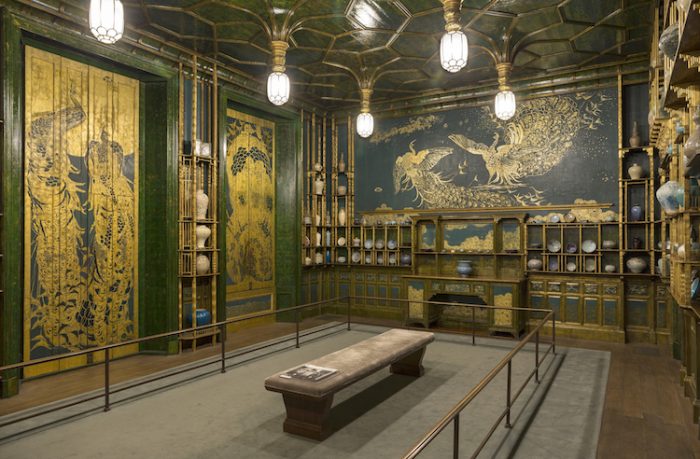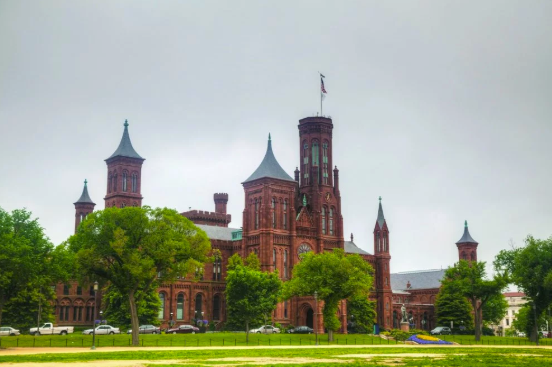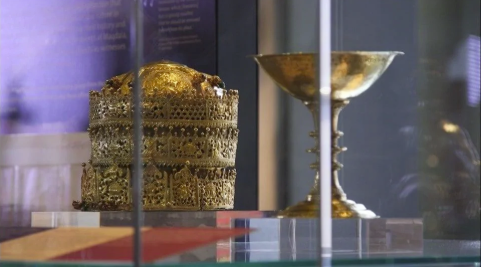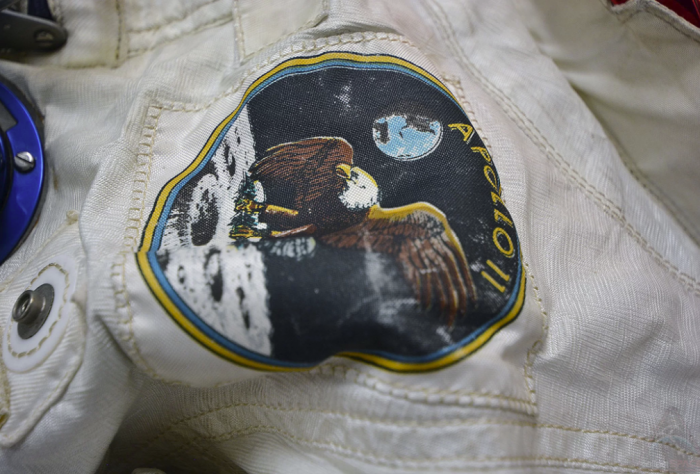ICYMI: Highlights from the week that was Sept. 9 – Sept. Sept. 15, 2018
No one can keep up with everything, so let us do it for you. We’ll gather the top Smithsonian stories from across the country and around the world each week so you’ll never be at a loss for conversation around the water cooler.
This week, we pondered the future, remembered the past and wondered whether two wrongs ever make a right.

This Golden ‘Peacock Room’ Is a Masterpiece Transported Across the Ocean
My Modern Met, Sept. 11

Smithsonian photo
Imagine a room so special that it was dismantled, packed into 27 crates, and floated across the ocean. In 1904, that’s just what happened to The Peacock Room—a decorative masterpiece by heralded American artist James Abbott McNeill Whistler.
You might be wondering What makes this room so intriguing that it was floated across the Atlantic from England to America? Well, the Peacock Room was originally designed as a dining room for British shipping magnate Frederick Richards Leyland and is considered an excellent example of the Japonism that pervaded late-19th century Europe. Originally entrusted to British architect Thomas Jekyll, the room was designed to show off Leyland’s impressive collection of blue and white Chinese porcelain. Read more from Jessica Stewart for My Modern Met.
Here’s Why That Fire at Brazil’s National Museum Probably Can’t Happen Here
The Smithsonian museums are much better protected.
Washingtonian, Sept. 11

iStock photo by Andrey Krav
A fire tore through the National Museum of Brazil during the night of September 2, destroying nearly 90 percent of its 20 million artifacts. The skull of Luzia, part of the oldest remains found in the Americas, as well as countless cultural and linguistic records of peoples who have disappeared, are among the items feared lost.
But could a similar tragedy happen in Washington? It’s very unlikely. The Smithsonian puts a great deal of thought into protecting its buildings and artifacts, according to J. Andrew Wilson, who oversaw fire safety for the museums from 1979 until 2011. “My mission at the Smithsonian for my 32 years there was to make it so the fire department never needed to be called,” he says. Wilson helped build fire-suppression systems that work automatically, “able to control or extinguish a fire without the assistance of the fire department.” Read more from Adia H. Robinson for Washingtonian.
Is it okay to steal back looted colonial-era treasures? (Opinion)
The Washington Post, Sept. 12

London’s Victoria and Albert Museum has put Ethiopian treasures plundered by British forces on display. (Reuters)
Rising powers from the so-called global south are putting their former Western colonizers on notice: They want their looted treasures — and their historical dignity — back.
In China, it is estimated that up to 10 million antiquities have disappeared since 1840, the beginning of the so-called Century of Humiliation. In a great piece for GQ, Alex Palmer writes, “The modern Communist Party has declared its intent to bring China back from that period of prolonged decline, and the return of looted objects serves as undeniable proof—tangible, visible, and beautiful proof—of the country’s revival.” According to Palmer, Chinese billionaires have been using their wealth to acquire Chinese art from European firms. More stunningly, highly skilled thieves have targeted Europe’s museums, brazenly stealing Chinese antiquities that were looted during the 19th century. Read more from Karen Attiah for The Washington Post.
National Air and Space Museum to Mark Apollo 11 50th Anniversary
Space.com, Sept. 13

The Apollo 11 mission patch on astronaut Buzz Aldrin’s spacesuit. Aldrin wore the suit (and patch) on the surface of the moon on July 20, 1969, almost 50 years ago.
Credit: collectSPACE.com
The Smithsonian’s National Air and Space Museum will commemorate the 50th anniversary of NASA’s Apollo 11 mission with a week-long “First Moon Landing Celebration” in July 2019.
Museum officials on Wednesday (Sept. 12) announced the celebration and plans for a series of events and exhibits to lead up to the anniversary beginning in October. The Smithsonian includes in its collection the spacecraft, spacesuits and much of the equipment that astronauts Neil Armstrong, Buzz Aldrin and Michael Collins used to achieve the first lunar landing on July 20, 1969.
“We see the Apollo 50th anniversary as an opportunity to introduce a whole new generation to what happened during our lifetimes,” said Valerie Neal, space history department chair at the National Air and Space Museum. “The majority of our visitors now were born after 1969. They know the story secondhand, but they don’t have that visceral experience of it.” Read more from Robert Z. Pearlman for Space.com
When a Famous Person Dies, the National Portrait Gallery’s “Rapid Response” Team Jumps Into Action
Prince. Aretha Franklin. John McCain. The Portrait Gallery can often mount a tribute within 48 hours
Washingtonian, Sept. 13

Milton Glaser’s portrait of Aretha Franklin. Courtesy the National Portrait Gallery.
John McCain died on Saturday, August 25. The National Portrait Gallery had a black-and-white Steve Pyke portrait of him on its “In Memoriam” wall by 11:30 AM on the following Monday.
In museum terms, this is lightning speed: The concept-to-wall process usually takes three to four years. But over the past 12 years the Portrait Gallery has developed a rapid response team that’s extremely good at memorializing the deaths of high-profile people. McCain’s portrait went up nine days after the Portrait Gallery got Milton Glaser’s 1968 portrait of Aretha Franklin on the wall the day after her death.
“It’s an interesting snapshot of the exhibit process in miniature,” says Alex Cooper, the head of exhibit technology at the gallery. “All the teams that are involved in full-blown exhibitions are involved.” Read more from Regina Park for Washingtonian.
The Future of the Arts and Industries Building? The Future Itself
The Georgetowner, Sept. 13

Helen DuBois, Gertraud Hechl of Bonhams and Rachel Goslins, director of the Arts and Industries Building. Photo by Robert Devaney.
At Georgetown Media Group’s Sept. 13 Cultural Leadership Breakfast at the George Town Club, Rachel Goslins, director of the Smithsonian Arts and Industries Building, explained to attendees that the focus of the shuttered landmark’s future will be just that: the future.
The building’s new role, distinct from its neighbor museums, will be “to explore these big questions on our horizon … through the Smithsonian lens,” she said, meaning a generally optimistic view of human creativity and ingenuity.
Though “A.I.B.” is the second-oldest Smithsonian building on the Mall — it opened as the National Museum soon after it hosted James Garfield’s inaugural ball in 1881 — it has a history of displaying technological wonders, starting with marvels of engineering from the 1876 Centennial Exposition in Philadelphia. And in the middle of the 20th-century, Goslins noted, “it was the Air and Space Museum for 30 years.” Read more from Richard Selden for The Georgetowner.
New gazelle, symbol of grace, born at National Zoo
The Washington Post, Sept. 14

National Zoo photo
Many animals reside in the National Zoo, but not all can be regarded as living representations of qualities we regard as attractive. So apart from its value in species conservation, the recent birth of a gazelle there may lift the hearts of all of us.
A gazelle, it may be recalled, is said to be the embodiment of grace. Graceful as a gazelle is the oft-heard phrase. On Thursday, the zoo announced that, on Sept. 7, it welcomed a new male dama gazelle. Read more from Martin Weil for the Washington Post.
Posted: 19 September 2018
-
Categories:
Air and Space Museum , Portrait Gallery , Zoo & Conservation Biology Institute





